
(a)
To indicate:
The movement that represents an unanticipated expansionary government policy in the short run.
Answer to Problem 3P
The movement of the equilibrium from point A to point F is due to an unanticipated expansionary government policy in the short run.
Explanation of Solution
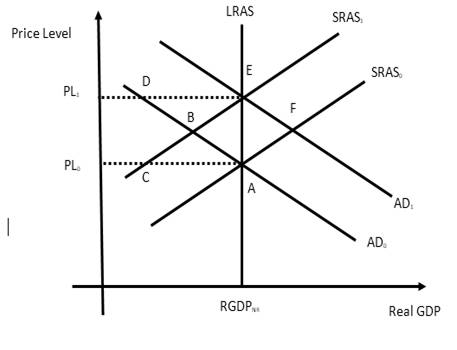
The economy was in the initial equilibrium at point A with the intersection of AD0 and SARS0. At point A, the expected
Now, suppose the government wants to lower the
As the expansionary fiscal policy is implemented, the aggregate
Expansionary government policy:
The government policies that cause the aggregate demand of the economy to rise and thereby induce production and income along with the generation of employment is referred as the expansionary government policy. The tools used by the government for this purpose
(b)
To indicate:
The movement that represents an unanticipated contractionary government policy in the short run.
Answer to Problem 3P
The movement from equilibrium point F to equilibrium point A represents the unanticipated contractionary government policy.
Explanation of Solution
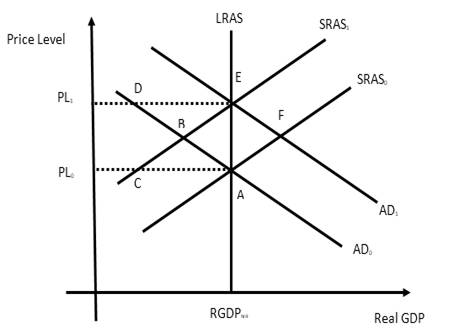
The economy is in the long run equilibrium at point A with real
To bring back stability to the economy, government takes measures that shifts the aggregate demand curve to the left to its original position, which is only possible when the government pursues a contractionary fiscal policy. However, if the contractionary fiscal policy is unanticipated, the public will maintain its expectation about the price level and therefore, the short run aggregate supply curve will remain unaffected. A contractionary fiscal policy affects the aggregate demand by lowering it from its current level for all prices and thereby shifting the aggregate demand curve back from AD1to AD0. With no change in the position of the short run aggregate supply curve due to the unanticipated nature of the policy, the shift in the aggregate demand curve will being the economy back to the old equilibrium at point A from point F.
Contractionary government policy:
The government policies that cause the aggregate demand of the economy to fall and thereby discourages production and generation of income along with employment is referred as contractionary government policy. The tools used by the government for this purpose are taxation and government expenditure. For the contractionary purpose, the government may either raise the tax rate or lower its expenditure or both. Contractionary government policy, also called contractionary fiscal policy, help the economy control inflation by lowering the circulation of money in the economy.
(c)
To indicate:
The movement that represents an anticipated expansionary government policy under the rational expectations.
Answer to Problem 3P
The movement from point A to point E represents completely anticipated expansionary government policy under rational expectations.
Explanation of Solution
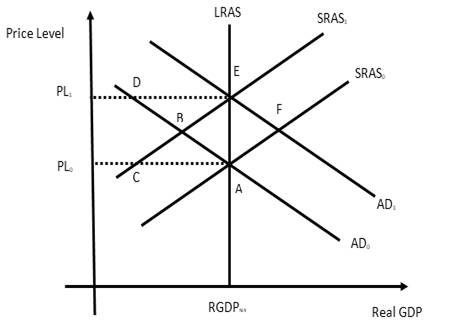
When an expansionary fiscal policy is completely anticipated, public by virtue of rational expectation will know from before that there will be a rise in the price level due to the policy. They immediately revise their activities and thereby changes the position of the short-run aggregate supply curve. Labor will revise their wages upwards; household will revise its spending; producers will lower production due to rising cost and so on which will shift SRAS0to SRAS1 even before the policy comes into effect creating a new short run equilibrium point at R. As the expansionary policy is implemented, the shift in the aggregate demand curve from AD0to AD1 generates the long run equilibrium at point F, where the economy is in the long run potential level of output with a higher price level.
Expansionary government policy:
The government policies that cause the aggregate demand of the economy to rise and thereby induce production and income along with the generation of employment is referred as the expansionary government policy. The tools used by the government for this purpose taxation and government expenditure. For the expansionary purpose, the government may either lower the tax rate or increase its expenditure or both. Expansionary government policy, also called expansionary fiscal policy, can help the economy move out of a recessionary situation.
Rational expectations:
People make decisions based on three primary factors, namely human rationality, available information, and experiences. The theory of rational expectation suggests that the current expectation of people can influence the future state of the economy.
(d)
To indicate:
The movement that represents an anticipated contractionary government policy in the short-run.
Answer to Problem 3P
The movement from point E to point F represents completely anticipated contractionary government policy in the short run.
Explanation of Solution
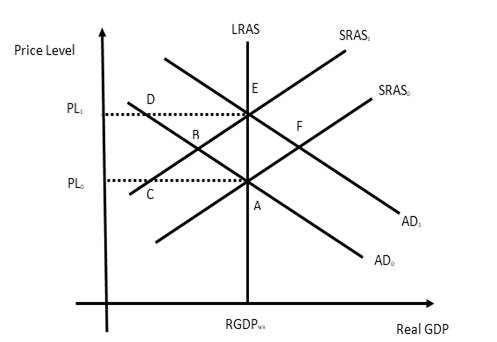
Suppose the economy is in long-run equilibrium at point E. At this point, the government plans a contractionary fiscal policy. If the move is completely anticipated, public will know from before that a contractionary fiscal policy will lower the price level. They will immediately revise their activities and that will cause the short run supply curve to shift rightwards from SRAS1 to SRAS0 even before the policy is implemented. Thus, the economy will move to a new short run equilibrium at point F.
Contractionary government policy:
The government policies that cause the aggregate demand of the economy to fall and thereby discourages production and generation of income along with employment is referred as contractionary government policy. The tools used by the government for this purpose are taxation and government expenditure. For the contractionary purpose, the government may either raise the tax rate or lower its expenditure or both. Contractionary government policy, also called contractionary fiscal policy, help the economy control inflation by lowering the circulation of money in the economy.
(e)
To explain:
The result of a situation where an expansionary government policy is made, but the inflationary effects of this policy is less than expected.
Answer to Problem 3P
If the expansionary fiscal policy results in the less than expected inflation, it will inhibit the growth in output and employment.
Explanation of Solution
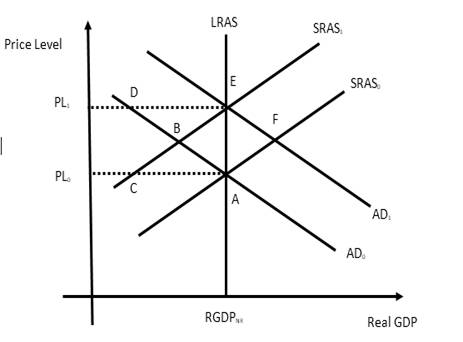
The expansionary fiscal policy boosts the aggregate demand which in turn puts an upward pressure on the price level. The rising price level encourages businesses to expand production level and generate income and employment. However, in case the fiscal policy fails to create the desired level of inflation, it will generate less impetus for the businesses to produce more and thereby inhibit the growth of output and employment.
Expansionary government policy:
The government policies that cause the aggregate demand of the economy to rise and thereby induce production and income along with the generation of employment is referred as the expansionary government policy. The tools used by the government for this purpose taxation and government expenditure. For the expansionary purpose, the government may either lower the tax rate or increase its expenditure or both. Expansionary government policy, also called expansionary fiscal policy, can help the economy move out of a recessionary situation.
Want to see more full solutions like this?
- Consider the figure at the right. The profit of the single-price monopolist OA. is shown by area D+H+I+F+A. B. is shown by area A+I+F. OC. is shown by area D + H. ○ D. is zero. ○ E. cannot be calculated or shown with just the information given in the graph. (C) Price ($) B C D H FIG шо E MC ATC A MR D = AR Quantityarrow_forwardConsider the figure. A perfectly price-discriminating monopolist will produce ○ A. 162 units and charge a price equal to $69. ○ B. 356 units and charge a price equal to $52 for the last unit sold only. OC. 162 units and charge a price equal to $52. OD. 356 units and charge a price equal to the perfectly competitive price. Dollars per Unit $69 $52 MR 162 356 Output MC Darrow_forwardThe figure at right shows the demand line, marginal revenue line, and cost curves for a single-price monopolist. Now suppose the monopolist is able to charge a different price on each different unit sold. The profit-maximizing quantity for the monopolist is (Round your response to the nearest whole number.) The price charged for the last unit sold by this monopolist is $ (Round your response to the nearest dollar.) Price ($) 250 225- 200- The monopolist's profit is $ the nearest dollar.) (Round your response to MC 175- 150 ATC 125- 100- 75- 50- 25- 0- °- 0 20 40 60 MR 80 100 120 140 160 180 200 Quantityarrow_forward
- The diagram shows a pharmaceutical firm's demand curve and marginal cost curve for a new heart medication for which the firm holds a 20-year patent on its production. At its profit-maximizing level of output, it will generate a deadweight loss to society represented by what? A. There is no deadweight loss generated. B. Area H+I+J+K OC. Area H+I D. Area D + E ◇ E. It is not possible to determine with the information provided. (...) 0 Price 0 m H B GI A MR MC D Outparrow_forwardConsider the figure on the right. A single-price monopolist will produce ○ A. 135 units and charge a price equal to $32. B. 135 units and generate a deadweight loss. OC. 189 units and charge a price equal to the perfectly competitive price. ○ D. 189 units and charge a price equal to $45. () Dollars per Unit $45 $32 MR D 135 189 Output MC NGarrow_forwardSuppose a drug company cannot prevent resale between rich and poor countries and increases output from 3 million (serving only the rich country with a price of $80 per treatment) to 9 million (serving both the rich and the poor countries with a price of $30 per treatment). Marginal cost is constant and equal to $10 per treatment in both countries. The marginal revenue per treatment of increasing output from 3 million to 9 million is equal to ○ A. $20 per treatment, which is greater than the marginal cost of $10 per treatment and thus implies that profits will rise. ○ B. $20 per treatment, which is greater than zero and thus implies that profits will rise. ○ C. $30 per treatment, which is greater than the marginal cost of $10 per treatment and thus implies that profits will rise. ○ D. $5 per treatment, which is less than the marginal cost of $10 per treatment and thus implies that profits will fall. ○ E. $30 per treatment, which is less than the marginal revenue of $80 per treatment…arrow_forward
- Consider the figure. A single-price monopolist will have a total revenue of Single-Price Monopolist OA. 84×$13. O B. 92x $13. OC. 84×$33. OD. 92 x $33. C Price ($) $33 $13 MC MR D 84 92 Output The figure is not drawn to scale.arrow_forward10.As COVID-19 came about, consumers' relationship with toilet paper changed and they found themselves desiring more than usual. Eventually, toilet paper producers saw an opportunity to make more money and meet the growing demand. Which best describes this scenario as depicted in Snell's 2020 article? A. The demand curve shifted left and the supply curve shifted left B. The demand curve shifted left and the supply curve shifted right C. The demand curve shifted right and the supply curve shifted left D. The demand curve shifted right and the supply curve shifted rightarrow_forward5. Supply and Demand. The graph below shows supply and demand curves for annual medical office visits. Using this graph, answer the questions below. P↑ $180 $150 $120 $90 $60 $30 4 8 12 16 20 24 28 32 36 a. If the market were free from government regulation, what would be the equilibrium price and quantity? b. Calculate total expenditures on office visits with this equilibrium price and quantity. c. If the government subsidized office visits and required that all consumers were to pay $30 per visit no matter what the actual cost, how many visits would consumers demand? d. What payment per visit would doctors require in order to supply that quantity of visits? e. Calculate total expenditures on office visits under the condition of this $30 co- payment. f. How do total expenditures with a co-payment of $30 compare to total expenditures without government involvement? Provide a numerical answer. Show your work.arrow_forward
- 4. The table below shows the labor requirements for Mr. and Mrs. Howell for pineapples and coconuts. Which is the most accurate statement? A. Mrs. Howell has a comparative advantage in coconuts and the opportunity cost of 1 coconut for Mrs. Howell is 4 pineapples B. Mrs. Howell has a comparative advantage in pineapples and the opportunity cost of 1 pineapple for Mrs. Howell is .25 coconuts. C. Mr. Howell has a comparative advantage in pineapples and the opportunity cost of 1 pineapple is 1 coconut. D. Mr. Howell has a comparative advantage in both pineapples and coconuts and should specialize in pineapples. Labor Requirements for Pineapples and Coconuts 1 Pineapple 1 Coconut Mr. Howell 1 hour 1 hour Mrs. Howell 1/2 hour 2 hoursarrow_forward4. Supply and Demand. The table gives hypothetical data for the quantity of electric scooters demanded and supplied per month. Price per Electric Scooter Quantity Quantity Demanded Supplied $150 500 250 $175 475 350 $200 450 450 $225 425 550 $250 400 650 $275 375 750 a. Graph the demand and supply curves. Note if you prefer to hand draw separately, you may and insert the picture separately. Price per Scooter 300 275 250 225 200 175 150 250 400 375425475 350 450 550 650 750 500 850 Quantity b. Find the equilibrium price and quantity using the graph above. c. Illustrate on your graph how an increase in the wage rate paid to scooter assemblers would affect the market for electric scooters. Label any new lines in the same graph above to distinguish changes. d. What would happen if there was an increase in the wage rate paid to scooter assemblers at the same time that tastes for electric scooters increased? 1ངarrow_forward3. Production Costs Clean 'n' Shine is a competitor to Spotless Car Wash. Like Spotless, it must pay $150 per day for each automated line it uses. But Clean 'n' Shine has been able to tap into a lower-cost pool of labor, paying its workers only $100 per day. Clean 'n' Shine's production technology is given in the following table. To determine its short-run cost structure, fill in the blanks in the table. Fill in the columns below. Outpu Capita Labor TFC TVC TC MC AFC AVC ATC 1 0 30 1 1 70 1 2 120 1 3 160 1 4 190 1 5 210 1 6 a. Over what range of output does Clean 'n' Shine experience increasing marginal returns to labor? Over what range does it experience diminishing marginal returns to labor? (*answer both questions) b. As output increases, do average fixed costs behave as described in the text? Explain. C. As output increases, do marginal cost, average variable cost, and average total cost behave as described in the text? Explain. d. Looking at the numbers in the table, but without…arrow_forward
 Exploring EconomicsEconomicsISBN:9781544336329Author:Robert L. SextonPublisher:SAGE Publications, Inc
Exploring EconomicsEconomicsISBN:9781544336329Author:Robert L. SextonPublisher:SAGE Publications, Inc
 Economics (MindTap Course List)EconomicsISBN:9781337617383Author:Roger A. ArnoldPublisher:Cengage Learning
Economics (MindTap Course List)EconomicsISBN:9781337617383Author:Roger A. ArnoldPublisher:Cengage Learning







